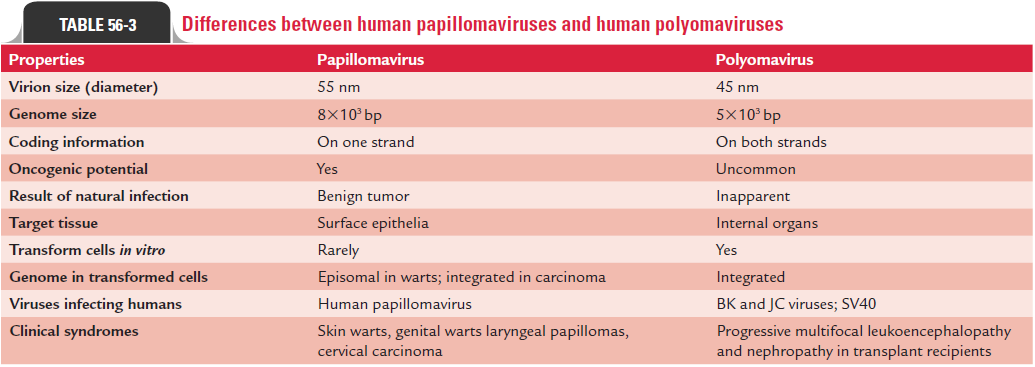Chapter: Microbiology and Immunology: Virology, Virus: Papovaviruses
Polyomavirus
Polyomavirus
Simian virus 40 (SV40) is the prototype polyomavirus studied extensively for eliciting different properties of the virus. The human polyomaviruses, such as BK and JC viruses, usually cause asymptomatic infection in humans. Polyomaviruses (poly, many; oma, tumor) are smaller viruses than papillomavi-ruses, measuring 45 nm in diameter. They are nonenveloped viruses with a 72-capsomere icosahedral capsid.
Viral genome is a double-stranded DNA containing less nucleic acid, approximately 5000 bp. The genomes of poly-omaviruses (BK, JC, and SV40) are similar to each other. The genome is divided into early, late, and noncoding regions. The early region codes for nonstructural transformation pro-tein, while the late region codes for three viral capsid proteins, such as VP1, VP2, and VP3. The noncoding region contains the site of the origin of DNA for replication. Differences between HPV and polyomaviruses are summarized in Table 56-3.

Different polyomaviruses show different host specificities. Human polyomaviruses, such as JC and BK, probably enter through the respiratory tract, and then subsequently infect lymphocytes and the kidneys. The BK viruses cause latent infec-tion of the kidney and of B cells. The pathogenesis of the human polyomavirus infection in humans depends on the immune status of the host. In the immunocompetent host, the replica-tion of viruses is inhibited. Suppression of immunity in patients receiving organ transplantation or suffering from AIDS results in reactivation of latent JC and BK viruses. In these patients, reactivation of viruses leads to shedding of viruses and symp-tomatic infection. The reactivation of BK viruses causes severe urinary tract infection with excretion of the virus in urine. Reactivation of JC viruses causes viremia and spread of the virus to the central nervous system (CNS), causing infection of the CNS.
All the polyomaviruses (BK, JC, and SV40) are known to cause tumor in animals, such as hamsters. These viruses, how-ever, are not associated with any tumors in humans.
Primary infection by human polyomaviruses is mostly asymp-tomatic in immunocompetent host. In immunocompromised host, the tissues are reactivated causing many serious diseases.
Both JC and BK viruses are ubiquitous. Most people are infected by these two viruses by the age of 15 years. Both the viruses are probably transmitted by respiratory route.
BK virus is associated with hemorrhagic cystitis in the bone marrow recipients. It also causes urethral stenosis in patients receiving kidney transplant.
JC virus was first isolated from the brain of a patient with Hodgkin’s disease, who developed progressive multifocal leukoencephalopathy (PML). PML is a subacute demyelin-ating disease of the CNS and is usually fatal. This disease occurs usually in immunocompromised patients including the patients with AIDS, Hodgkin’s disease, and chronic lym-phocytic leukemia.
The SV40 shows oncogenic potential in newborn hamsters, but is not associated with any human disease. The SV40, however, has a public health importance. Earlier, some batches of polio vaccines, which were prepared in the simian cell culture were contaminated with undetected SV40 virus in the primary monkey cell cultures. However, no SV40-related tumors have been reported so far, although many people were vaccinated with these SV40 contaminated polio vaccines.
Electron microscopy is useful to detect JC virus in brain tissue from the cases of PML and from urine of kidney transplant recipients. Immunoperoxidase and in situ immunofluorescence are rapid detection methods for detection of viral antigen in brain tissue obtained by biopsy or at autopsy.
BK polyomavirus is isolated from urine by culture in human diploid fibroblasts; JC virus is isolated from urine and brain tissue by culture in human fetal glial cell culture. Hemagglutination inhibition test is performed to differentiate these two viruses.
No specific antiviral treatment is available for polyomavirus infections in humans. Prevention of polyomavirus infection is difficult due to ubiquitous presence of these viruses.
Related Topics